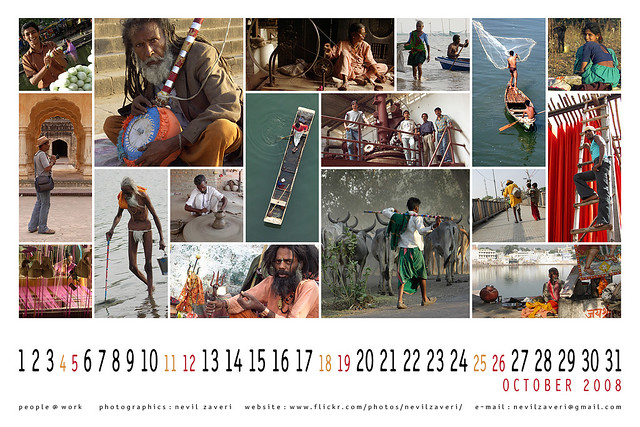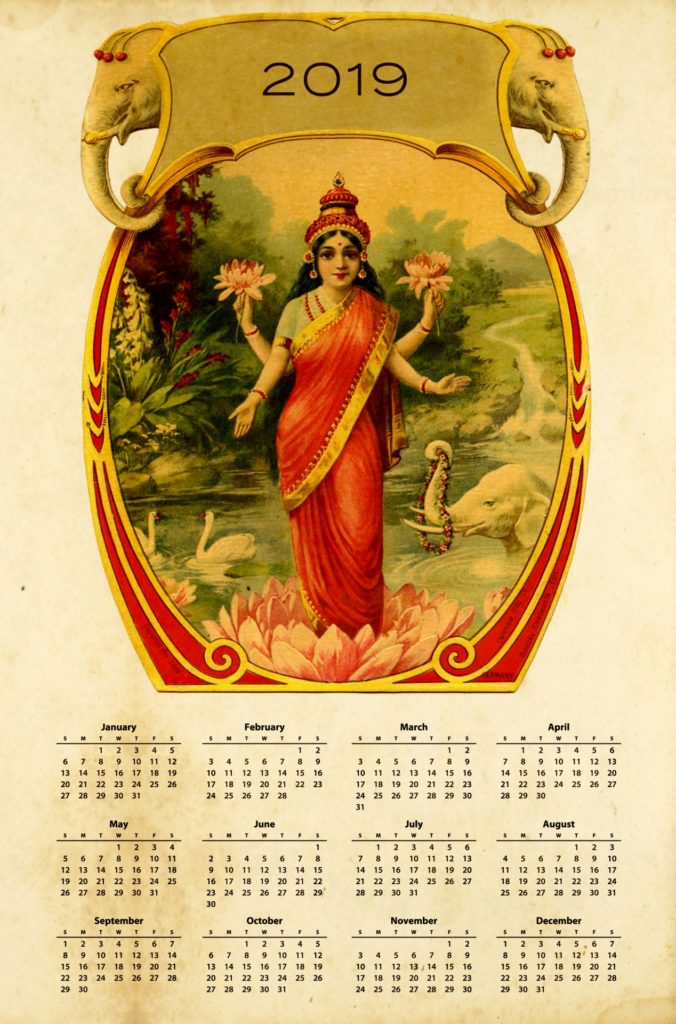
In this rapidly changing world of technology and development, a lot of traditional utilitarian items, art forms, etc. are gradually vanishing from our daily lives. Some of these like calendars, tape recorders, etc. which once used to be an important part of every household in terms of both utility and reflecting social status, are now getting lost in the hustle of modernising our lifestyles. For most of the generation of youth which grew up in the 90s, calendars were one of those elements in home which were always taken for granted and are now only acquired by antiquarians or used only in small towns or cities.
In India, calendar art gained popularity with the initiative of Raja Ravi Verma, the father of modern art (also calendar art) in India. He pioneered the setting up of one of the earliest lithographic presses in India. Verma perfected the western models of representation and popularised the images of Gods and Goddesses which he rendered so real. As calendars became affordable for the general population, the printers diversified their themes over the period of time accordingly to maintain relevance in society.

As the freedom movement gained momentum, allegory and imagery related to freedom symbols and the idea of an independent Indian nation was universalised all over the country through calendars. This significantly impacted in bringing a sense of nationalism and cultural integrity.
Calendars also became a social symbol and marker of a person’s/family’s religious affiliation or faith and belief system. The late nineteenth and early twentieth century saw a sudden surge in the culture of popular images like those of Hindu Gods and Goddesses, mythological tales, portraits of nationalist leaders and landscapes being created by the artists. As the country became independent and the path of unity in diversity was being paved, calendar printing presses further expanded their scope. Besides the Hindus, all kinds of myths, folk culture and stories pertaining to various religions were represented. This also contributed in familiarising the umbrella structure of a religious faith in the far corners of the country, as a certain kind of representation gained acceptance in people’s minds.
Also, in colonial and post-colonial India, devotional aesthetics rapidly dominated the political level so that the nation was first and foremost evoked in allegory. This became a prominent political tool to gather masses. The boundaries between the sacred and political merged into each other as the nation was represented in religious terms. The calendars etched the symbolism of Mother India, cow as representation of nation, etc. into the minds of masses.
However, as India advanced and stepped into the globalised world, new calendar themes were introduced. On one hand was the attempt to preserve the culture and therefore types of folk dances, folk festivals, popular places, sceneries gathered from across India were printed on calendars. On the other end, there were huge companies which introduced calendars promoting and advertising their own products. Models were employed by companies like Kingfisher, Suzuki, etc. to make them more appealing to the public. Calendars were distributed to employees by both private and public sector institutions, and thus still making its way into almost every household.

Calendars had another crucial utilitarian role to play. The holidays, festivals, etc. were determined by these. This was an immensely difficult task in light of the existence of such a large number of different dating systems and eras. In 1928, Times of India reported ‘A war of calendars’ between Maharashtrian Hindus. Such incidents occurred because traditional calendars used locally no longer correspond to seasons or predicted events easily. Even a Calendar Reform Committee set up by the government of India in 1953 wasn’t able to provide a solution which would appeal to all groups. Ultimately, the public resorted to various alternatives like purchasing hybrid calendars showing traditional information laid out in the structure of Gregorian calendar.
Calendars are still visible sometimes, though only with a functional use in limited households that too mostly in kitchens or in offices as a few desk calendars, but that’s almost all extent of their use these days. Problematic themes like objectifying women (once the most popular tool of big companies) or even Gods (one can purchase a poster for display) are now mostly avoided. Animals or landscapes are common on desk calendars bought from charities along with quotes or personalised theme based ones as a thoughtful gift.
With the increasing trend of flats as preferred form of house combined with new structures and interior designing like glass windows, lack of space, etc. and also the technological advancement which has made all the information available on the tips of fingers at all times, digital calendars, constrained marketing budgets, etc. has rendered calendars a thing of the past. They have lost their functional use and are also no longer needed to decorate or signal our allegiances.
Thus, calendars, once a fundamental item in every household and also a tool of mass appeasing in ways of framing and changing public opinion, a social symbol, a company’s integrative gift to its employees. In just two decades, are almost on the verge of being lost in oblivion and becoming a thing of the past, like many others which met a swift end due the rapid wave of technological advancement. Calendars now mostly find their way mostly in the house of prominent art collectors, exhibitions and auction houses as they lose the battle against modernity.
Arushi is pursuing her Masters in History from Delhi University. Exploring culture, society and learning about various facets of humanity has intrigued her since childhood and thus she aspires to contribute her bit in making the world a better place.
The writer had just finished her M.A. in History from Delhi University and preparing for further studies. Exploring culture, society and learning about the various facets of humanity has intrigued her since childhood and thus she aspires to contribute her bit in making the world a better place.


